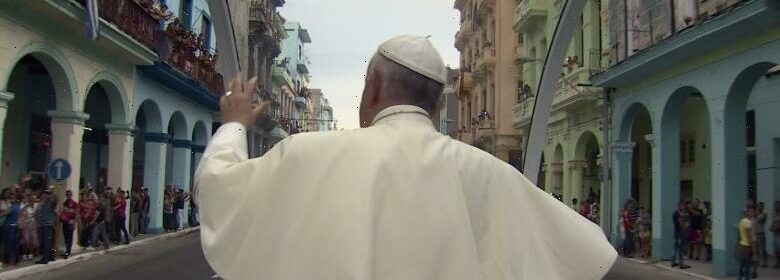‘In Viaggio’ Review: Pope Francis Doc Gives Unprecedented Access to a Papal Life

If there is anything that “In Viaggio”, “The Young Pope”, and “The Two Popes” have recently taught us, it’s that being the Pope is pretty weird. Even when you take away the pristine white robes; handmade Italian shoes; the kissing of strangers; and jazzy little popemobile, you are still left with a man with an overwhelmingly huge and often bizarrely contradictory remit.
The documentary “In Viaggio” is made up of archival footage over 9 years, starting when Jorge Mario Bergoglio became Pope Francis in 2013. The Argentine bouncer turned janitor turned scientist turned man of god was celebrated as representing a progressive new era for Catholicism. His predecessors, Pope John Paul II and Benedict XVI, had died and retired respectively with the dark cloud of the child sex abuse scandal above them but Pope Francis was an opportunity for the Vatican to draw a line in the sand and no longer tolerate such atrocities.
The film has unprecedented access to the Pope, starting with an intimate shot of his face and shoulders, hunched like a Rodin sculpture being crushed by a divine burden. We are told that in his commitment to reach those who need his help the most he visited 37 countries over the course of shooting. This is made more impressive when you take into account the years that Covid swallowed and the man’s age, now in his mid 80s he spends many visits looking exhausted and limping from speech to diplomatic meeting. Francis is nothing if not determined, on stormy days donning a yellow plastic sheet over his ceremonial garb in order to speed through the rain to meet the Jesus-loving masses.
The film has a wonderful recurring shot, with a camera affixed to the back of the Popemobile facing his back. From country to country we see the crowds lining the street and Pope Francis turning to wave at crowds that run from respectful but taciturn to full blown Beatlemania.
The film is most interesting when it explores the full weight of what the Pope is up against, be it climate change, war, poverty, or pandemic. It begins with a harrowing distress call to the Italian coastguard; a boat carrying 250 migrants is attempting to cross the Mediterranean when a storm hits and it capsizes. The line goes sickeningly silent before the screaming man can give a location and all the lives onboard are lost. The Pope appears to feel this deeply and on the verge of tears as he grimly states that this event is a “thorn in my heart,” where “boats instead of symbols of hope become symbols of death.” He pauses, looks out at the crowd and seems to meet each person in the eye and begs for compassion and for each person to receive the burden of what this indifference to our fellow man’s suffering has resulted in, “this is a society that has forgotten how to weep.”
From country to country the message is different, but Pope Francis, for all the glitzy regalia and five-star treatment he receives (including plane flanked by fighter jets to get him to his destination) always seems happiest when meeting with the poor and dispossessed. In the Philippines he touches foreheads in prayer and gleefully kisses babies. In Mexico he visits prisoners and seems to grant each one some hope by meeting them one by one, greeting them with the respect of equals. And in Palestine he looks to the 66-year-old refugee camps and seems equally determined for a better future when an activist says, “We will reclaim peace. We will reclaim freedom.”
In the midst of all this global turmoil the filmmakers give us a glint of dark humor in his visit to America. He enters Congress to a warm standing ovation and all seem on board when he starts his speech, praising American icons like Abraham Lincoln, Martin Luther King Jr, and politically radical American Catholic Dorothy Day. The room turns as he begins speaking about the ingloriousness of war and by the time he is describing the military industrial complex as “Money drenched in blood!” you can practically hear the politicians squirming in their seats.
The documentary is remarkable for its access into Pope Francis’s life and its elegant footage, stylishly directed and edited by Gianfranco Rosi. No doubt the Pope is a remarkable man who handles with aplomb his life vacillating wildly between motivational speeches and apology tours. He apologizes to the Indigenous Canadians for the Catholic Church’s role in their colonization. He apologizes to the members of the Orthodox Church as the split in 1054 meant there were missed opportunities for cooperation. Most of all he apologizes for the child sex abuse throughout the ages and in turn has to apologize again when he tacitly supports an accused priest in Chile and says “Bring me proof. Until then it is slander.”
That rare misstep is a fascinating moment in the film because the man’s fallibility is otherwise not called into question. To make an error is of course human, but to quickly recognize your mistake and do everything in your power to correct it is divine.
Maybe what makes this pope different is his ability to know when he is wrong. That amid the climate crisis, migrants drowning in the sea, pandemic, war and genocide the most important thing the Pope can be is a person that can course-correct. The enduring message of the film is not just that Papal duties, from defending the Armenian genocide to chatting to the International space station have the most incredible and bizarre scale, but that a message of hope comes with a proviso. We can all, individually or collectively, see the error of our ways and build a better world, so long as we don’t wait too long to do it.
Grade: B
“In Viaggio” premiered at the 2022 Venice Film Festival. It is currently seeking distribution.
Source: Read Full Article